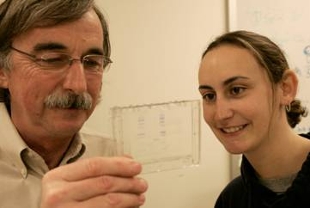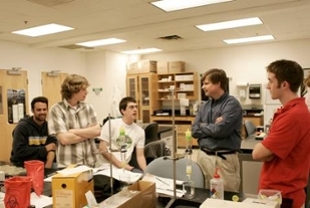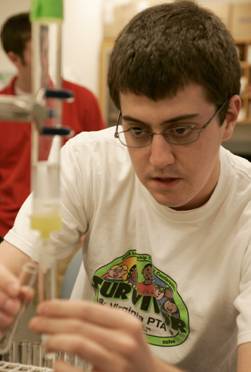Ducts out of water: JMU faculty and students work to help find a new treatment for dry-eye syndrome
NewsBy Charles Culbertson
The waiting rooms of eye doctors throughout the United States are filled with patients seeking relief from one of the most common and irksome of ailments: dry-eye syndrome. Finally, research is under way that may give sufferers real, lasting relief and JMU is at the forefront of those efforts.

Nothing to blink at
Upwards of 35 million Americans suffer from an inability to produce tears in sufficient quantity and quality to lubricate the eyes, and the result can be a maddening ocular cocktail of itching, burning, irritation, redness, blurred vision, sensitivity to light and periods of discomfort after reading, watching television or working on a computer. And since aging is one of a number of causes of dry-eye syndrome, the condition will likely become even more prevalent as baby boomers grow older.
Other causes include the environment, systemic drug therapy, surgery, allergies, autoimmune diseases, glaucoma, infections, trauma or contact lens wear.
Since the common denominator in all these causes is a decrease in both volume and quality of tear secretion, the most frequent solution has been relatively straightforward if not enduring the topical application of drops that serve as artificial tears. But topical treatment, which requires users to apply drops at intervals throughout the day as needed, poorly emulates the complex composition of tear layers and does nothing more than wet the surface of the eye.
Now, however, science and technology are uniting to possibly create a real solution to the absence-of-tears problem. Assuming a pivotal role in the development of that solution are biotechnology faculty and students in the Integrated Science and Technology Program at James Madison University who are manufacturing a protein that could actually help stimulate new tear production.
Origins at UVa.

The project began at the University of Virginia where Dr. Gordon W. Laurie, an associate professor in the department of cell biology and director of UVa.'s Biotechnology Training Program, developed an interest in dry-eye syndrome, its causes and treatments. His research led to the discovery of what he described as "a novel human tear glycoprotein produced solely by lacrimal and salivary glands" that, when tested in the laboratory, suggested a potential for actually generating new tears.
With the discovery, however, came a problem. The protein, which Laurie named lacritin, appears naturally in human tears, but not in enough quantities to allow for animal testing.
Laurie had heard of JMU's biotechnology concentration within the ISAT program and thought perhaps it could help solve the lacritin problem.
"Dr. Laurie gave me a call and I invited him over to give a talk to our students," said Dr. Robert McKown, an ISAT professor and director of JMU's Biotechnology Laboratory. "We began discussing research and both of us realized we had areas of expertise that would complement each other. We soon developed a very strong and productive collaboration."
That collaboration, which began in 2002, would grow to include EyeRx Research Inc. and Eastern Virginia Medical School, both in Hampton Roads. James Madison would provide the bench work the cloning, expression (reproduction) and purification of lacritin while participants from EyeRx would focus on such scientific elements as experimental design, data analysis, report writing and ensuring that the project retained its clinical focus. The role of the Thomas R. Lee Center for Ocular Pharmacology at EVMS would be to conduct animal testing once the lacritin was produced. Laurie, as the discoverer of lacritin, would lend his expertise and knowledge of the protein's cellular and molecular properties.

Bench work begins
The bench work got under way in 2003, funded by a federal grant from the National Eye Institute of the National Institutes of Health, with McKown and Dr. Ronald W. Raab, associate professor of ISAT, taking the lead in JMU's biotechnology labs. It was not, however, an endeavor exclusive to James Madison faculty. One of the leading elements of the ISAT program is active participation in research and development by students, and it was an element that McKown and Raab immediately applied to the lacritin project.
McKown approached his biotechnology seniors who were searching for senior thesis topics, explained what JMU and its partners were trying to do, and asked if anyone was interested. Thesis team members Angela Peterson of Londonderry, N.H., and Staci Johnson of Virginia Beach, Va., were attracted to the project right away.
"When I heard about the lacritin project, I knew I wanted to do it because it wasn't just your usual senior thesis project something people do just to get it out of the way," Johnson said. "I thought how fulfilling it would be if I could help develop something that would one day be on a pharmaceutical shelf."
Peterson's reaction to McKown's pitch was much the same.
"I wanted to help with the project for several reasons," she said. "First, it would give me some really good laboratory experience, which I wanted and needed. Second, I'd be building on the work that ISAT students before me had done, and third, there was the potential for helping develop a human therapeutic. We would be small cogs in a very big wheel in that regard, but it was exciting to think about being involved in it."
Peterson and Johnson were set to work learning how to conduct site-directed mutagenesis examining amino acids, changing nucleotides and studying the structure of lacritin. The learning curve sometimes frustrated them the students admit there were a lot of starts and stops, with a few dead ends and roadblocks along the way and when the lights in the lab went out late at night, sometimes they felt they were no further along in their work. But perseverance, and constant monitoring and mentoring by McKown and Raab, produced both the acquisition of knowledge and practical lab work necessary to further the project.
"One of the things that separates ISAT from other programs is that they don't just give you a protocol for how to do things," Peterson said. "Rather, they say, 'This is what we want you to do, figure it out.' I think because of that, I learned far more than I might have otherwise."
Testing made possible
The project resulted in the cloning, expressing and purifying of lacritin in amounts that could be used in tests on 24 female white New Zealand rabbits at EVMS. Rabbits are the most widely used species for ophthalmologic research because the human and rabbit eye share many anatomic and physiologic similarities. "There are no surgical procedures associated with this proposal," said the NIH grant proposal. "Any pain and distress experienced by the subjects will be minimized."

If those tests are successful in stimulating new tear production the results will be made available in the fall then lacritin could soon be used in a new treatment for dry-eye syndrome.
"Scientists accomplished the same thing with insulin," McKown said. "For years, insulin was available only in whatever quantities could be extracted from animals. The supply was, therefore, very limited. When cloning became possible, insulin was then reproduced in amounts that far exceeded what could be harvested from animals and revolutionized the treatment of diabetes."
McKown added that "Although JMU could eventually see a financial gain from manufacturing lacritin for medical use, the real excitement here is the knowledge that what we're doing may relieve human suffering."
The discoverer of lacritin is pleased with the JMU effort.
"It has been a great thrill to work with Bob McKown, Ron Raab, the highly energetic JMU students and Pat Williams from EVMS," he said. "We are all psyched by the shared efforts of our multi-institutional Virginia team and by the possibility that our joint work will lead to the first truly effective treatment for the world's No. 1 eye disease.
"Teaching students how to develop lacritin as a new dry-eye treatment, optimizing its production and efficacy, understanding mechanisms and clinical testing are expensive," he continued. "All would not be possible without National Eye Institute funding, but more is needed."
Other key personnel involved in the development of lacritin as a human therapeutic are Dr. John D. Sheppard Jr. and Dr. Earl R. Crouch Jr. of EyeRx; Dr. Frank A. Lattanzio and Dr. Patricia B. Williams of EVMS; and Dr. George L. Coffman, assistant professor of integrated science and technology at JMU.

